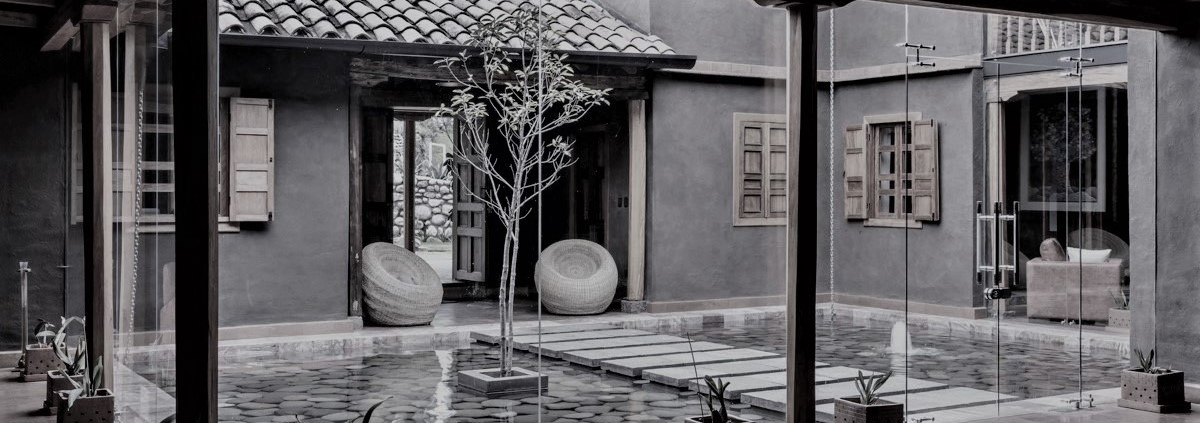Central Courtyard House
The courtyard house makes its first appearance ca. 6400–6000 BC (calibrated), in the Neolithic Yarmukian site at Sha’ar HaGolan, in the central Jordan Valley, on the northern bank of the Yarmouk River, giving the site a special significance in architectural history. In Ancient Roman architecture courtyard houses were built around an atrium. Courtyard houses are also common in Islamic architecture. Throughout history the courtyard house has played a major role, and only in the last couple of centuries has its use been neglected. Recently, more attention has been given to the courtyard house, as a type to solve a number of problems of dense inner city housing.
Whether viewed as space, building, or landscape, courtyard housing provided both concrete and symbolic references to the idea of shared life motivated by concerns higher than the pursuit of mere survival. In areas with vast dry spaces, the single-family house, as it floated in a continuous flat or undulating landscape, seemed incapable of defining such a community in form. The idea of place in this type of dwelling, is achieved by the exclusion of the surrounding context and by the definition of a protected interior realm that nurtures and safeguards private or limited shared values. The idea of enclosure becomes instrumental in the negation of exterior disorder and in the definition of the courtyard as a tool of collective identity. At all times, one registers the total building and not merely the sum of its parts, thereby compensating for lack of identity at smaller scale.
The dominant Iranian multifamily dwelling type was the low-rise, high-density courtyard building. There existed a multiplicity of such buildings bound to similarity by the exigencies of the type, but displayed a variety of specific solutions brought about by contextual, stylistic, programmatic, and other forces. The earliest and most numerous examples of courtyard housing are simple repetitions of the single-family house arranged in series. The salient architectural rules of this typology, as usual, were based on the pragmatics of construction, development, and user expectations. They were actually so obvious and explicit that most courts were built, not by architects, but by the people themselves, without reference to standards texts or the consciousness on commonly held values. When a building type is accepted not only as a means of organizing space and form, but also as a means of construction, then it enters with particular force into the realm of the builder.
As these locations shifted to accommodate an upper-class clientele, however, architects became increasingly involved in their design. They combine the advantages of compact, easily maintained living quarters with the provision of communal outdoor places for public contact. Single or multi family houses capitalized on the use of exterior space before the courts, and thus provided a tradition on which the courts could build. Porches, patios, balconies, and various other house extensions all became standard way to amplify interior spaces. Planting in private spaces became a developed art and contributed to the overall ambience of the court. High living-room ceilings and cross ventilation became standard way to offset the effects of dry, hot days and cool nights. The possibility of living indoors or outdoors under pleasant conditions, in natural surroundings, without being preoccupied about the weather and its effects, heightened the sense of well-being inherent in court living.
Central Courtyard House Features
The essence of the court house lies in the definition of an interior landscaped realm, separated from the street. This outdoor place is used in the summer as an extension of ground floor living room and is typically furnished with indoor furniture. Occasionally it is covered by a canvas canopy. This extension, provides both access and a realm for public activity. The courtyard and the surfaces that enclose it, constitute a precise attempt to recreate a street scene with all its variety of formal definition and accommodation of disparate activity. Some features that central courtyard dwellings have, or must comply with, are as follows:
- Its plan shape is typically rectangular;
- The courtyard always insistently expresses the imagery of the communal living room;
- The width of the courtyard, its relationship to the dwellings, and its connection to the city beyond, determine whether it is used as contemplative place or merely as a route for pedestrian circulation;
- Its ground is carefully divided into hard and soft landscaping in order to direct movement, to screen dwellings, or merely to embellish;
- The regularity of entrances, the continuous surface, the repetitiveness of architectural elements, and the quality of the streetscape combine to provide a fine illusion of the organizational and expressive possibilities of the courtyard as place;
- There is direct access from all dwellings, whether ground or upper level, to the court;
- The passage from court to buildings, or from level to level is always articulated as portico, porch, front yard, or stair;
- Within the limited space of the court, building elements express or generate specific realms of activity or experience;
- Size differences aside, all units, whether attached or detached, consciously attempt to duplicate the amenities of the detached single-family house;
- The internal structure of the dwellings is dominated by the rules of access. These means of access are rigidly defined in spatial terms;
- The court is separated from street by an iron gate, a door, or a portico.
Integrating the Cars in Central Courtyard Houses
Court should integrate the car, without allowing it to tyrannize the dwelling. This accommodation is quite a radical departure in the history of residential building, and it reflects the unique admiration, acceptance, and love of automobiles that has characterized the modern culture influences. Parking garages could occur:
- In the rear, with side service driveway;
- Directly off the street on sloping sides;
- Hollowed out under the central courtyard.
I these ways, the automobile is incorporated into the complex without intruding upon open space.
Courtyard House Types
The Single-Bar Parti
The initial formulation of the courtyard as place in none other than the street.
The Double-bar Parti
The double-bar parti is a rare one, because it needs a powerful identity to convey uniqueness of a space. Sloping sites permit sensitive articulations of the domain of the individual dwellings. With the unavailability for access and parking can transform it to cul-de-sac street.
The L Parti
The L parti is the first which begins to define the enclosure of the courtyard by means of the building form. Especially when located on a sloping site, such courts suffer from a weak overall definition of the central courtyard.
The U Parti
Court of this kind are surrounded on three sides by buildings and most typically are located with their open end facilitating the street. The front of court at street is could be completed with a thin wall screen connecting the two front bars of the U, so the definition of the court become powerful. In situation of generous land, the bars of the U could turn at the end as if to suggest the ultimate act of enclosure. Accommodation of cars in this type is very easy. In cases of uphill courts, the cars could be nestled underneath the first terrace.
The Completed Courtyard Parti
The completed courtyard parti is the most accomplished realization of the court typology. Here the city in all its manifestations definitely excluded. This parti is strong enough to accept access from two sides, and still retain the integrity of the central space. Typically, the central space is a regular grid, a rectangle or square, dimensioned in such a way as to accept a fountain, garden or a pool in its center. The courtyard always insistently expresses the imagery of the communal living room. When building distorted by topography, the differences in level should taken up as an architectural element in the courtyard and be hidden in the body of the building itself. Their neutral exteriors, left urban spaces for the benefit of vehicles and representing some kind of stiff, formal public behavior, while behind the walls of the courts lurk all the forbidden temptations to act privately and freely.
Multi/Special Parti
The completed courtyard parti could multiplied or distorted by unique contextual conditions. Such cases offer the best illustration of the capability of courtyard house to adapting to the urban or site structure. Where two kind of spaces exist as separate domains, it can generates substantial variety of places and multiplies the possibilities of diverse experiences within the buildings. These spaces can organized without a defined center, but all flowing into each other. The seeming irregularity of projecting building volumes and empty spaces, aim to contextual responsiveness, may generate and developed with discipline of form and structure the nostalgic sense of villages. The possibility of relating units to mini-courts within a single building, heightened the sense of identity of the inhabitants and generates a diversity of accommodation which is amazing if one considers the limits of land and building mass available.
Disappearance of Courtyard House
Decline and disappearance of Courtyard House as a vital element of urban morphology is due to a fundamental shift both in the principle of production and in the life possibilities associated with the single dwelling in the context of housing.




Leave a Reply
Want to join the discussion?Feel free to contribute!